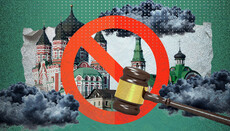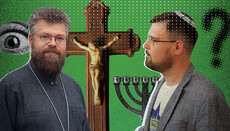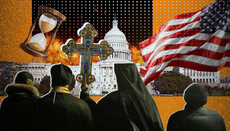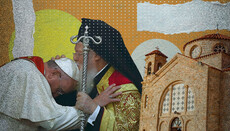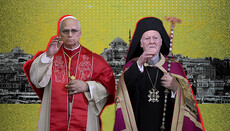What does the attempted seizure of Chernivtsi Cathedral mean?
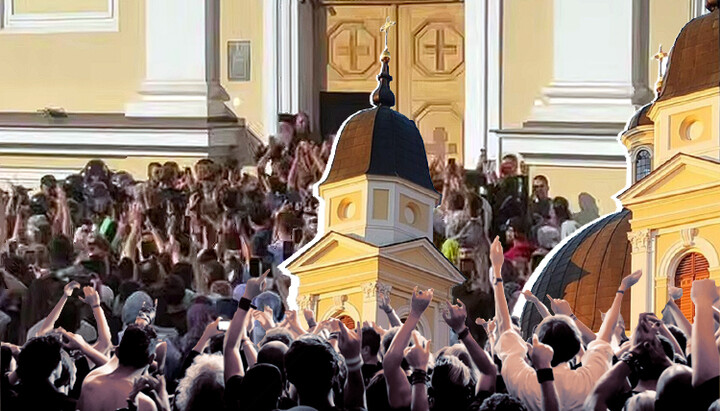
In Bukovyna, there was a large-scale and ultimately failed attempt to seize a UOC cathedral. The behavior of the raiders, representatives of the OCU, and the police speaks volumes. But what exactly does it say?
A brief summary of events
On June 17, 2025, some highly unusual “disabled persons” entered the Holy Spirit Cathedral of the Ukrainian Orthodox Church (UOC) in Chernivtsi. Surveillance cameras captured the moment: a young man was wheeled into the church by healthy-looking young men. But as soon as he crossed the threshold – miracle of miracles – he was suddenly healed and jumped to his feet. Yet instead of falling to his knees in gratitude to God, he began attempting to seize the church and prevent people from praying.
His accomplices – around 50 individuals – stormed the cathedral grounds and began beating anyone in their path.
This was a full-scale violent takeover, premeditated and carried out with particular cruelty. Two priests who tried to defend the sacred space were severely beaten. One, Father Roman, suffered broken ribs and internal injuries. The other, Archpriest Vitalii Honcharuk, sustained serious head trauma, including a broken nose and deep lacerations. Both were hospitalized. Meanwhile, the attackers pried open the doors of the candle shop with a crowbar and stole 60,000 UAH – a clear indication of their real motives.
The police, despite numerous emergency calls from the faithful, were in no hurry to respond. Those nearby, according to eyewitnesses, stood by and did nothing, effectively enabling the church raiders. And for a time, the attackers succeeded. They occupied the cathedral, blocked all entrances, and beat anyone who tried to come near.
Around the same time, “Bishop” Feognost Bodoriak of the Chernivtsi and Bukovyna Diocese of the OCU called the cathedral seizure a “historic event” and urged his subordinates to participate:
"Fathers, a historic event has occurred: we are inside the Holy Spirit Cathedral. (…) Everyone must urgently come to the city and gather with the faithful to support what’s happening in the cathedral. (…) This is not up for discussion. We plan to remain here even through the night. Fathers, I ask you to take this seriously – I expect you all,” he wrote," he wrote to his subordinates.
But either his “fathers” didn’t take it seriously, or the OCU simply lacked the numbers – because their show of force failed. Meanwhile, UOC believers began to gather at the cathedral. More and more came – not with violence or aggression, but simply to enter the church where they had always prayed.
And now the police, who had stood idly by during the violent assault, suddenly sprang into action – forming a human shield to keep the faithful out. Those who tried to get closer were tear-gassed and beaten with batons.
Metropolitan Meletiy of Chernivtsi and Bukovyna arrived on site, only to be sprayed in the face with tear gas. One police officer even threw the bishop to the ground.
The Metropolitan appealed to the UN, the OSCE, U.S. Vice President J.D. Vance, and the White House Office of Faith-Based and Neighborhood Partnerships, asking them to protect religious freedom in Ukraine from lawless militants.
When the crowd of faithful grew large enough, they eventually succeeded in reclaiming the cathedral grounds. The raiders were forced out – not simply chased off, but evacuated in an organized manner by the police.
After the faithful regained control of the cathedral, Metropolitan Meletiy thanked them and addressed both Patriarch Bartholomew and the head of the OCU, Serhiy (Epifaniy) Dumenko. He reminded the former that it was his Tomos granted to the OCU that had paved the way for this lawlessness. And he challenged the latter, asking why he was seizing churches that belong to others when the OCU’s own churches – such as those in Dumenko’s native Bukovyna – stand empty.
Legal assessment of the situation
From a legal standpoint, the entire event is a clear and blatant violation of the law: hired thugs assaulted clergy and looted the church's funds. But there are some peculiar nuances.
That the attackers grossly violated the Constitution and laws of Ukraine is obvious. That their actions fall under numerous articles of the Criminal Code is equally obvious. And that these crimes were committed under aggravating circumstances is also clear. But the open complicity of the police in these criminal actions is beyond comprehension.
And this is not the first such case. Police officers have repeatedly taken part in acts that are patently illegal and punishable under criminal law.
All evidence suggests that the seizure of the Holy Spirit Cathedral was premeditated and carefully coordinated. Every participant – police included – seemed to know their role.
Law enforcement did not respond to legitimate demands by believers to stop the crimes. They allowed the attackers to storm the church and prevented the faithful from defending their legal rights. Worse still, they used force against peaceful citizens, and even physically assaulted Metropolitan Meletiy. When the faithful finally managed to reclaim the church, the police evacuated the criminals instead of arresting them on the spot or launching criminal proceedings – as the law requires. This clearly implies that the radicals knew in advance they would not be held accountable, and that authorities would shield them from any consequences.
This is why Metropolitan Meletiy – and others – have had to turn to international organizations and foreign political leaders for protection of religious freedom. Such protection, it seems, can no longer be found within Ukraine itself. Nevertheless, filing formal complaints with law enforcement remains necessary – because sooner or later, Ukraine must return to the rule of law.
Religious assessment
What happened recently in Chernivtsi – and earlier in Cherkasy and many other cities and villages across Ukraine – is not merely the actions of isolated thugs who have no understanding of what Christianity is, what the Gospel commands are, or what fruits of the Holy Spirit should be manifest in true followers of Christ.
All this violence and lawlessness is directly sanctioned by the religious authorities of the Orthodox Church of Ukraine (OCU) and the Ecumenical Patriarchate of Constantinople.
As early as October 11, 2018, when the Synod at the Phanar decided to recognize the schismatics of the UOC-KP and UAOC and merge them into a single religious structure, the hierarchs in Constantinople knew full well this would lead to violence and religious strife. Even then, they attempted – like a certain well-known biblical figure – to wash their hands of it. Their synodal decision included Clause 5, which stated: “To call upon all involved parties to avoid the appropriation of churches, monasteries, or any other property, as well as all acts of violence and retaliation, so that the peace and love of Christ may prevail.”
And yet, for more than six years now, the OCU – under the spiritual jurisdiction of the Ecumenical Patriarchate – has been doing exactly that: seizing churches and other property by force. The Patriarchate of Constantinople, instead of calling on them to stop (in accordance with Clause 5), not only remains silent but honors them, celebrates joint services, exchanges gifts and visits. In other words, the Ecumenical Patriarchate has fully aligned itself with the violence and lawlessness perpetrated by the OCU. And if the OCU is now widely known as the “church of crowbars and grinders,” what then does that make the Phanariots – given that the OCU’s Tomos states they recognize the Ecumenical Patriarch as their head?
As for the OCU itself, there’s little left to say. Not only does it fail to denounce the outrages committed by its supporters, not only does it reward them – it directly participates in the crimes. The role of the OCU’s “bishop” in Chernivtsi, Feognost Bodoriak, has already been discussed above. And the day after the seizure, it emerged that the operation was overseen by a cleric of the OCU, Ivan Chokaliuk – reportedly the uncle of Epifaniy Dumenko himself.
It is also important to note the actions of UOC believers in this situation. Despite facing brute physical force, the police, and local authorities – who had publicly stated their intention to shut down the UOC – they still came to defend their sacred space. Around 5,000 people gathered, and their sheer numbers allowed them to reclaim the cathedral. This is a great achievement. It appears that only by assembling en masse and showing the world that the UOC is truly the Church of the Ukrainian people can believers resist the raiders. Against such numbers, neither the police nor the attackers had any effective countermeasure.
But Chernivtsi is a large city with many faithful. What are Christians in small towns and villages to do? It seems they have only one option left: to bear witness to their faith and their Church. And that, in God’s eyes, is of the greatest value.
Political assessment
At the outset of the full-scale war, Ukrainian authorities declared that society must not be divided along religious lines, as this would lead to defeat. Later, they reversed that position – but the fundamental truth remains unchanged. Sowing division within Ukrainian society – especially religious division – and fueling hostility between citizens, only serves the enemy. It weakens Ukraine and, ultimately, could bring about its downfall.
The facts are clear: Ukraine’s government is deliberately inciting religious hatred and dividing the Ukrainian people.
It must also be noted that the Bukovyna region has its own particular characteristics. In regions like Lviv or Ivano-Frankivsk, public sentiment is largely negative toward the UOC (though this is no justification for violating freedom of religion). But in Bukovyna, the UOC enjoys widespread respect. Metropolitan Meletiy, Metropolitan Longin, and many other bishops are deeply revered by the people. The OCU, on the other hand, has very few supporters in this region. As Metropolitan Meletiy noted in his public statement, even the OCU church in the village of Stara Zhadova – hometown of Epifaniy Dumenko – stands empty. Virtually no one goes there to pray.
This attempted violent seizure of the cathedral in Chernivtsi is therefore either a staggering display of government incompetence or a deliberate provocation aimed at sparking social unrest. But to what end?
Bukovyna borders Romania, and many of its Orthodox residents are either of Romanian descent or hold pro-Romanian sentiments. Church pogroms like these could easily alienate them from the Ukrainian state and drive them to seek protection across the border. This is especially likely given the surge of critical coverage in the Romanian press regarding the seizure of the Holy Spirit Cathedral in Chernivtsi – coverage that has rightly outraged Romanian citizens and authorities alike.
Why are Ukraine’s central authorities not only allowing such anti-Ukrainian actions at the local level, but seemingly encouraging them? Why are they fueling separatist sentiment in Ukraine’s regions? Are these actions born of sheer foolishness – or of a conscious effort to dismantle the state from within? Shouldn’t true patriots of Ukraine begin asking these questions of their government?
Furthermore, this brutal suppression of religious freedom in Ukraine severely damages the country’s image in the eyes of Western European nations, the United States, and others. It offers additional arguments to political forces – many of whom are now in power in their respective countries – who advocate for ending support to Ukraine.
Final thoughts
The parishioners of Chernivtsi have defended their cathedral. The faithful of the Ukrainian Orthodox Church do not bend before the authorities – they remain steadfast in their loyalty to Christ and His Church. The past years of intense persecution have proven one thing clearly: a church building can be taken away, but faith cannot. The Church in Ukraine will endure – of that there is no doubt.
Once again, the OCU has lived up to its reputation as the “church of crowbars and grinders.” Once again, it has shown the world what it truly is and what spirit animates it. After everything that has transpired in recent times, it’s hard to imagine anyone still having illusions about its nature.
Even its most loyal theologians are beginning to ask questions. For instance, Yuriy Chernomorets addressed Epifaniy with the following appeal: “Every fellow citizen must be treated as one's own child. Everything possible must be done to prevent violence and lawlessness. Cherkasy – now Chernivtsi. And supposedly only one side is to blame, just because they are ‘Moscow Church.’ But if they are, does that mean ‘anything goes’?”
The entire OCU project is yet another dark stain in the history of the Patriarchate of Constantinople. Perhaps not as large in scale as the Unions of Lyons or Florence, but equally shameful. One can only hope that in the future, the Church of Constantinople will find the courage to acknowledge its mistake and honestly record it in its own historical writings – just as it now writes about the rampant corruption during the Ottoman period, or the shameful deposition of great hierarchs like St. John Chrysostom (4th–5th c.), St. Germanus of Constantinople (8th c.), St. Nicephorus the Confessor (9th c.), and others, all for the sake of appeasing emperors.
The Ukrainian authorities are deliberately provoking division, hostility, and separatist sentiment. They are tarnishing Ukraine’s image abroad – and all of this in the midst of a war.
But on a spiritual level, the division is even more grave. People are placing themselves – either on the side of Christ and His Church, or on the opposite. May God grant everyone the strength to make the right choice.
